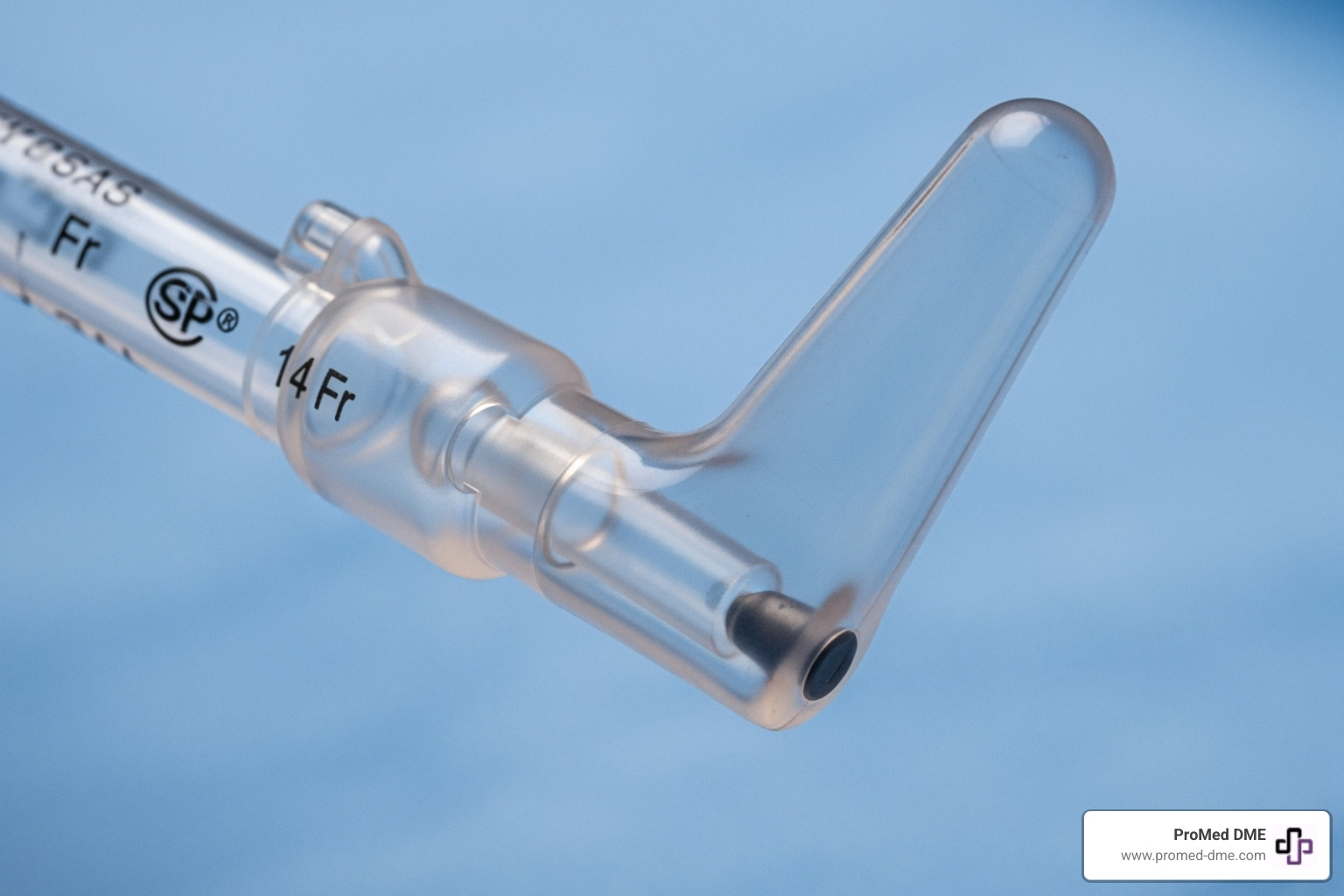The Prostate Puzzle: Self-Catheterization as a Solution for Enlarged Glands
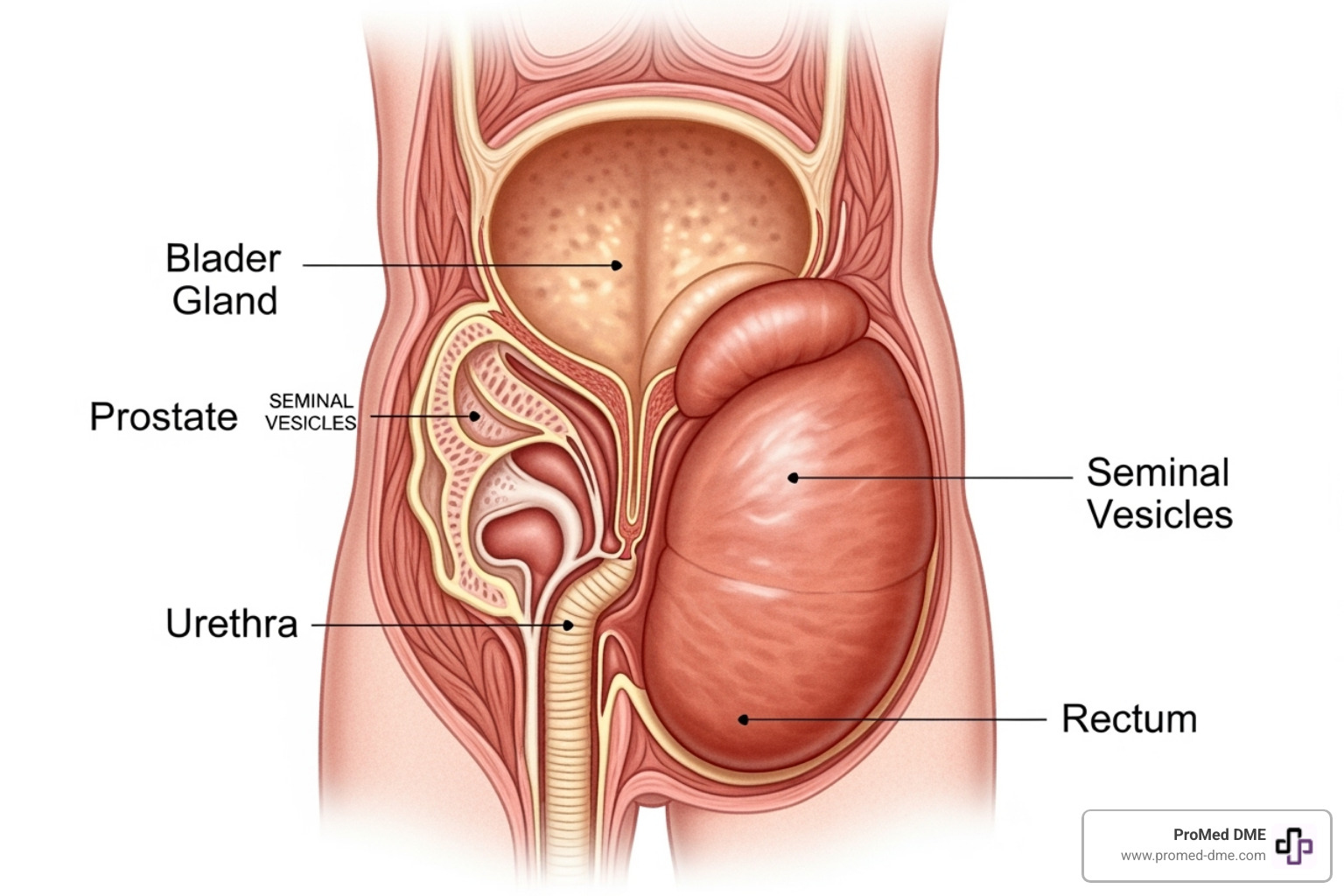
Why Self-Catheterization Matters for Men with Enlarged Prostates
Self-catheterization with enlarged prostate is a practical solution that helps men completely empty their bladder when benign prostatic hyperplasia (BPH) blocks normal urine flow. This safe, effective technique gives you control over your bladder symptoms and prevents serious complications like kidney damage.
Quick Answer for Self-Catheterization with Enlarged Prostate:
- What it is: Using a thin tube (catheter) to drain urine when your prostate blocks normal flow
- When needed: If you can't fully fully empty your bladder due to BPH symptoms
- How often: Typically 4-6 times daily, keeping volumes under 400ml
- Benefits: Complete bladder emptying, reduced infection risk, improved quality of life
- Catheter size: Most men use 14-16 French catheters
- Insurance: Usually covered by Medicare, Medicaid, and private insurance
If you're one of the 50% of men over 50 who experience an enlarged prostate, you know the frustration. That weak stream. Getting up multiple times at night. The feeling that your bladder never fully empties.
Benign prostatic hyperplasia is the most common cause of bladder problems in maturing men. As your prostate grows, it presses against your urethra like a clamp on a garden hose. This creates urinary retention - either chronic (gradual) or acute (sudden and serious).
But here's the good news: intermittent self-catheterization can give you back control. This technique lets you completely empty your bladder on your schedule, preventing the complications that come with chronic retention.
Many men worry about learning this skill, but it's easier than you think. With proper guidance and practice, self-catheterization becomes a routine part of managing your prostate health.
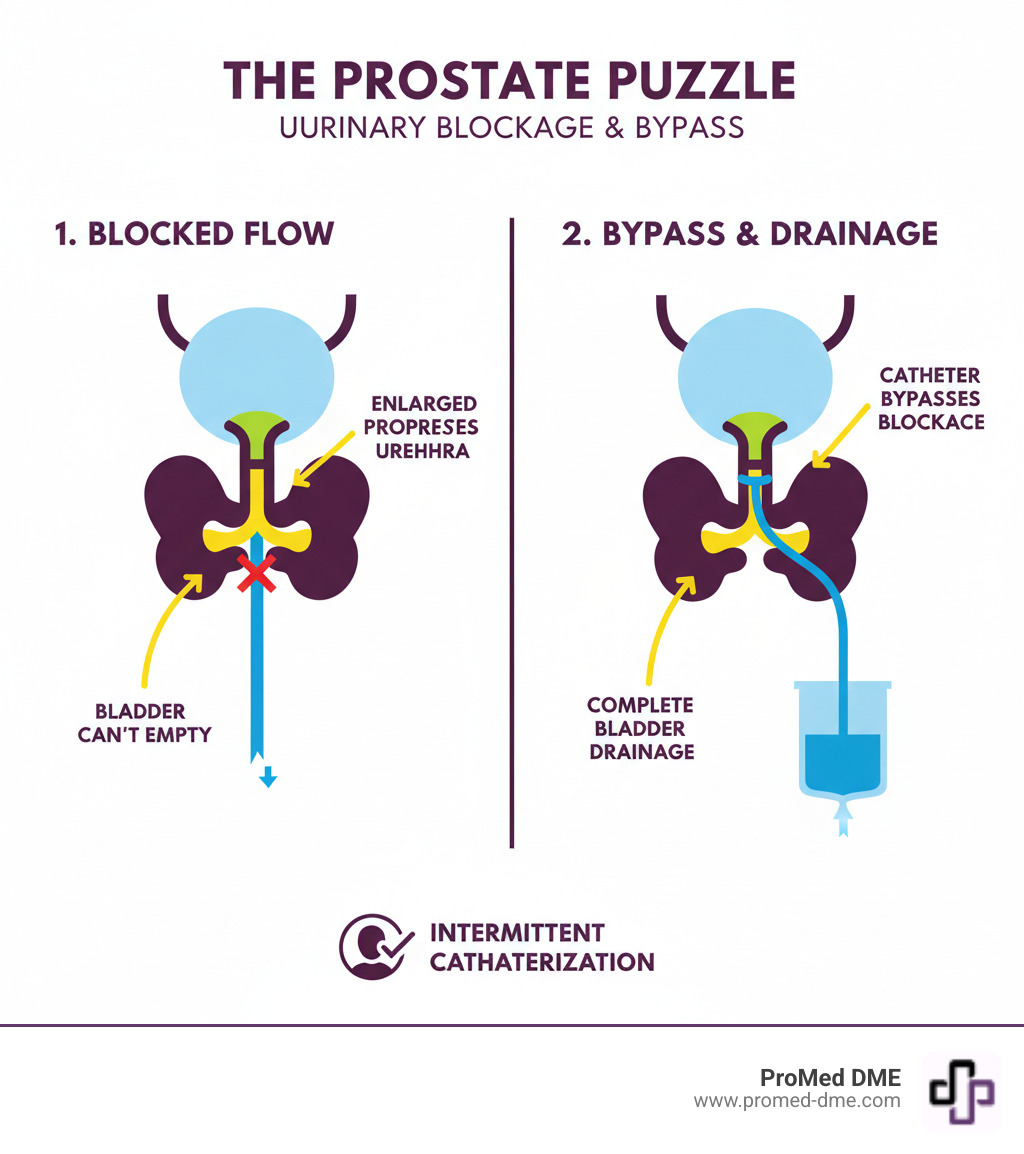
Understanding an Enlarged Prostate (BPH) and Urinary Retention
If you're over 50, you're not alone in dealing with prostate changes. Your prostate gland naturally grows throughout your life, and this common condition is called Benign Prostatic Hyperplasia, or BPH. Reassuringly, BPH is not prostate cancer and won't become cancer, but it can make your daily routine more challenging.
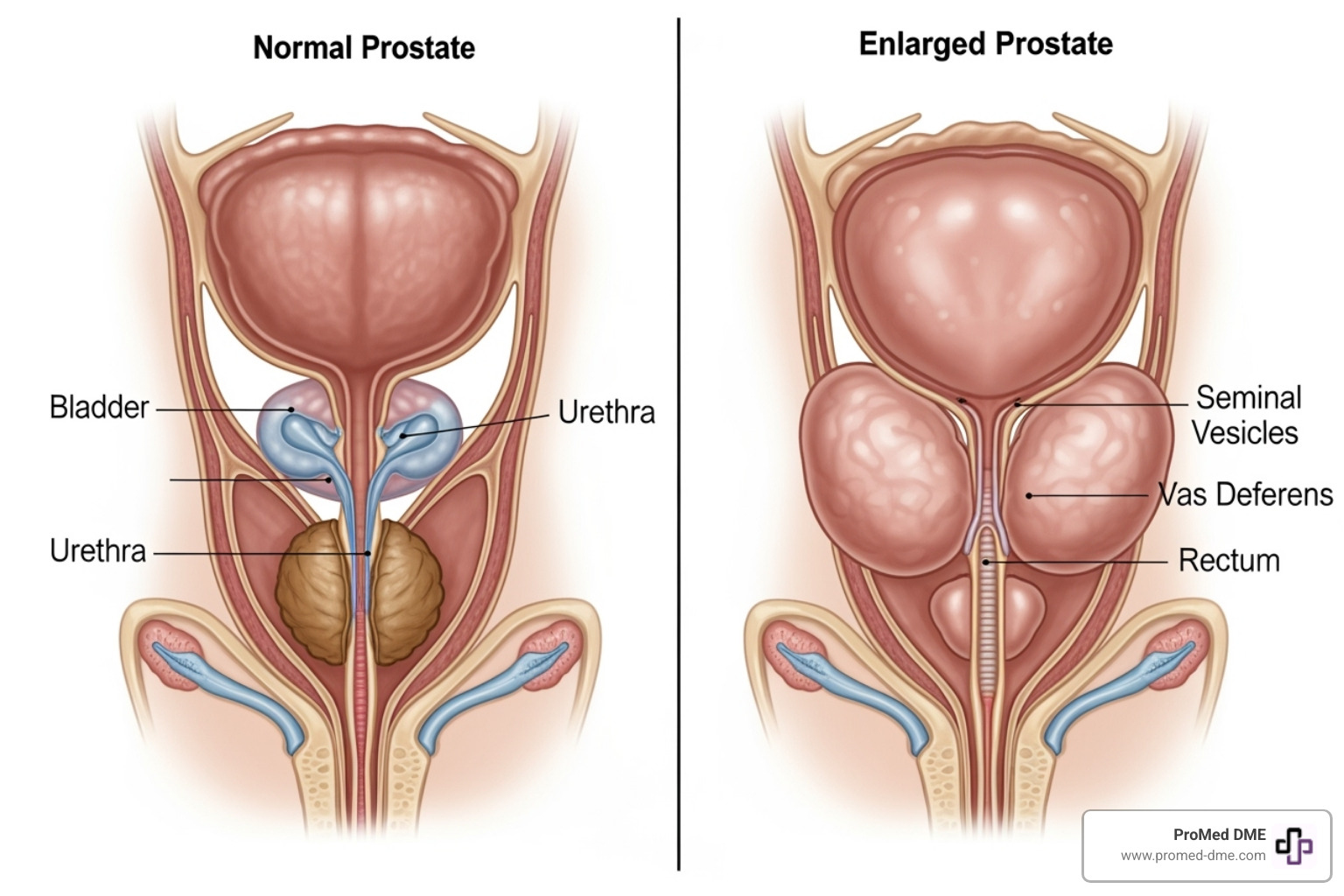
Think of your prostate like a donut sitting below your bladder. The urethra—the tube carrying urine out of your body—passes through the middle. When your prostate grows, it squeezes the urethra, restricting or even blocking your urine flow.
This compression creates frustrating symptoms you might recognize: Starting urination becomes difficult, your stream feels weak or stops and starts, and you feel like your bladder never fully empties.
Over time, your bladder muscle works harder to push urine past the squeezed urethra. Eventually, it can stretch and weaken, making the situation worse. The good news is you have options. Self-catheterization with enlarged prostate is one effective solution we'll explore, but it's part of a whole toolkit for managing BPH. Other treatments range from lifestyle changes and medications to various procedures. The key is working with your healthcare team to find what works best for you.
For more comprehensive information about BPH, the Benign Prostatic Hyperplasia explained resource from UrologyHealth.org offers excellent insights. Understanding your body is the first step toward taking control.
Chronic vs. Acute Urinary Retention
When your enlarged prostate interferes with urination, you might develop urinary retention—your bladder can't empty as it should. There are two very different types, and knowing the difference is crucial for your health.
Chronic Urinary Retention: The Slow Build-Up
Chronic retention sneaks up on you. You can still urinate, but some urine is always left behind, creating a cascade of problems over time. The symptoms develop slowly and might include frequent nighttime bathroom trips, a weak stream, and a persistent feeling of incomplete emptying. You might also experience dribbling or leakage because your bladder is constantly full.
What's concerning about chronic retention is that leftover urine causes your bladder to gradually stretch and weaken. This weakening makes your bladder even less effective at pushing urine out, creating a cycle that can lead to infections and, in severe cases, kidney damage.
Acute Urinary Retention: The Emergency
Acute retention is a medical emergency. It means you suddenly cannot urinate at all, despite having a full bladder. The symptoms are unmistakable: severe, sudden abdominal pain with an intense, urgent need to urinate that you cannot satisfy. Your lower abdomen may look visibly swollen.
Acute retention demands immediate medical attention. The pressure buildup can threaten your kidneys, and the pain is often unbearable. If you experience these symptoms, head to the emergency room right away.
Understanding these two types helps you recognize when you need gradual management versus emergency care. Chronic retention often responds well to techniques like self-catheterization with enlarged prostate, while acute retention requires immediate medical intervention.
The Solution: How Intermittent Catheterization Helps with BPH
When your enlarged prostate makes urination a daily struggle, self-catheterization with enlarged prostate offers a practical solution that puts you back in control. It allows you to bypass the obstruction entirely, meaning you can achieve complete bladder emptying every single time—something that becomes increasingly difficult as BPH progresses.
This complete emptying isn't just about comfort; it's about protecting your long-term health. When urine sits in your bladder, several problems can develop.
Reduced risk of kidney damage is a critical benefit. When your bladder can't empty properly, urine can back up into your kidneys, creating pressure that damages these vital organs. Clean Intermittent Catheterization (CIC) prevents this by ensuring your bladder empties completely.
Your bladder also benefits. Preventing bladder stretching keeps this important muscle healthy. When a bladder stays overfilled, it stretches and loses its ability to contract effectively. Regular catheterization maintains normal bladder size and function.
Perhaps most noticeable is the improved quality of life from reliable bladder control. No more planning your day around bathrooms, waking up multiple times each night, or worrying about incomplete emptying. You decide when and where to empty your bladder, giving you freedom you may not have felt in years.
Why Choose Self-Catheterization?
Self-catheterization with enlarged prostate offers unique advantages for men with BPH symptoms.
The technique mimics natural urination. Unlike permanent catheters that stay in place, intermittent catheters are used only when needed and then removed. This allows your body to function normally between catheterizations.
Avoiding indwelling catheters is a significant benefit. Permanent catheters carry higher infection risks and can be uncomfortable for daily activities. Intermittent catheterization sidesteps these complications.
The empowerment of self-management can't be overstated. Learning this skill gives you control over your condition. Many men find that mastering catheterization boosts their confidence and independence, turning a frustrating issue into a manageable routine.
Reduced worry about leakage brings tremendous peace of mind. When your bladder can't empty completely, overflow incontinence often follows. By ensuring complete drainage, catheterization eliminates this unpredictable problem.
Most importantly, intermittent catheterization serves as a non-surgical management option. While surgery for BPH can be effective, many men prefer to explore less invasive approaches first. Self-catheterization provides excellent symptom management, potentially allowing you to delay or avoid surgery.
This approach puts you in the driver's seat of your prostate health, offering a practical solution that works around your enlarged prostate.
Your Practical Guide to Self-Catheterization with an Enlarged Prostate
Starting self-catheterization with enlarged prostate can feel overwhelming, but thousands of men successfully master this skill. What seems intimidating at first can become as routine as brushing your teeth. Our team at ProMed DME has guided countless men through this process and is here to help.
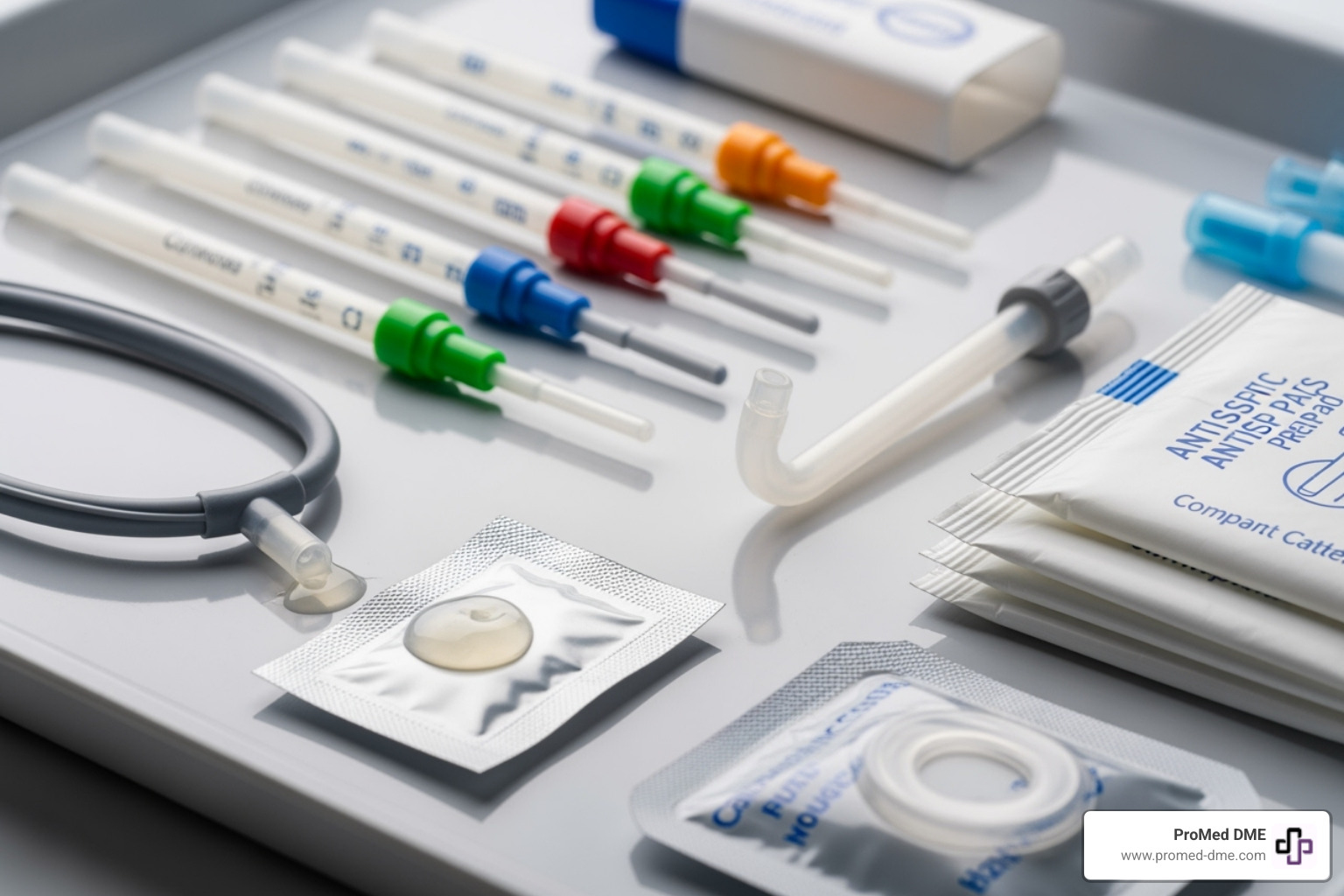
Hygiene is absolutely critical for safe catheterization to prevent infections. There is a learning curve, and your first few attempts might feel awkward or take longer. Don't get discouraged. With practice, the process becomes easier and faster. The key is following a regular schedule—typically every 4 to 6 hours—to prevent your bladder from becoming overfull.
Choosing the Right Catheter for Your Needs
Picking the right catheter makes all the difference in your comfort. Let's break down what you need to know.
Catheter materials vary, but most are made from medical-grade plastics like PVC, silicone, or flexible vinyl. Some catheters have special hydrophilic coatings that become slippery when wet, while others come pre-lubricated or require you to add lubricant.
The catheter size is measured on the French scale. For most men, 14 to 16 French catheters work best. The right size is important: too small can cause leakage, while too large can be painful and potentially harmful.
Catheter stiffness is another consideration. Some are more rigid for easier insertion, while others are softer and more flexible for comfort. Many catheters become slightly more pliable when they warm up to body temperature, which can make insertion more comfortable.
The tip type is especially important for men with enlarged prostates. Here's where the choice between straight tip and coudé tip catheters becomes crucial:
| Feature | Straight Tip Catheter | Coudé Tip Catheter |
|---|---|---|
| Appearance | Straight, rounded tip | Slightly curved or angled tip |
| Purpose | Standard insertion for uncomplicated urethras | Designed for easier navigation past obstructions or strictures |
| Best For | Men without significant urethral obstructions | Men with enlarged prostates (BPH), urethral strictures, or false passages |
| Insertion | Generally straightforward | Curved tip helps guide the catheter around the prostate or other anatomical challenges |
| Comfort | Often preferred if no obstruction, less friction | Can be more comfortable if a straight tip causes pain or difficulty due to obstruction |
For men with BPH, a coudé tip catheter (pronounced "koo-DAY") often makes insertion much easier. Its gentle curve is engineered to steer around the enlarged prostate, reducing discomfort. If a straight catheter is difficult or painful, discuss switching to a coudé tip with your provider.
Don't forget about lubrication - always use water-based lubricating jelly. Never use petroleum jelly like Vaseline, as it can cause problems. Many modern catheters come ready-to-use with pre-lubrication or water sachets that activate special coatings, making the process more convenient.
Step-by-Step: How to Perform Self-Catheterization
Learning the proper technique for self-catheterization with enlarged prostate is essential for your safety. While your healthcare provider will give you hands-on training, here's a general walkthrough of the process for men:
Gather supplies: Collect your catheter, water-soluble lubricant (if needed), antiseptic wipes, a container for urine (or use a toilet), and a clean towel. Keep everything within reach.
Wash your hands: This is your most important defense against infection. Scrub with soap and warm water for at least 20 seconds, then dry completely.
Find a comfortable position: Most men prefer standing in front of a toilet, sitting on the toilet seat, or sitting on the edge of their bed. Adjust your clothing for easy access.
Clean your penis: Gently wash the tip with soap and water or an antiseptic wipe. If you're uncircumcised, gently pull back your foreskin before cleaning, then remember to return it to its normal position afterward.
Prepare your catheter: Remove it from the packaging without touching the part that will enter your body. Apply a generous amount of water-based lubricating jelly to the tip and first 2-4 inches. If you have a pre-lubricated catheter, follow the package instructions to activate it.
Insert the catheter: Hold your penis straight up and slightly away from your body to straighten your urethra. Slowly and gently insert the lubricated catheter into the urinary opening.
Advance the catheter with steady, gentle pressure. You may feel resistance as it passes the prostate or sphincter. Taking a deep breath or coughing can help it pass. Continue advancing until urine flows.
Drain the bladder: Once urine flows, insert the catheter another 1-2 inches to ensure it's fully in the bladder. Allow it to drain completely, holding it steady until the flow stops. Gently pressing on your lower abdomen can help.
Remove the catheter slowly: Gently withdraw it. If more urine drains as you pull it out, pause and let it flow before continuing. Remove it completely once drainage stops.
Clean up properly: Dispose of single-use catheters in regular trash. If using a reusable catheter, clean it immediately as instructed by your provider. Always wash your hands again when you're done.
Feeling awkward at first is normal. If you experience ongoing difficulty or pain, contact your healthcare provider. We're here to help you become confident with this skill.
Essential Hygiene and Preventing Complications
Excellent hygiene during self-catheterization with enlarged prostate is critical for your health and safety. Poor hygiene can lead to serious complications, particularly infections.
Thorough hand washing before and after every catheterization is your strongest defense against introducing harmful bacteria into your urinary system.
Cleaning your genitals properly before each procedure reduces the number of bacteria around your urethral opening. Use mild soap and water or antiseptic wipes.
Using single-use catheters is the gold standard that most healthcare providers recommend. They are used once and thrown away, eliminating the risk of contamination from improper cleaning.
Handling sterile packaging correctly protects the catheter. Avoid touching the part that will enter your body. Many catheters feature "no-touch" designs with protective sleeves to minimize direct contact.
The most common complication is a Catheter-Associated Urinary Tract Infection (CAUTI). The CDC provides detailed information about Preventing Catheter-Associated UTIs (CAUTI) that's worth reviewing. Other potential complications include urethral damage from forcing the catheter, bladder spasms, and more serious infections.
Know when to call your provider. Contact your doctor immediately for signs of a urinary tract infection: fever, chills, foul-smelling or cloudy urine, blood in your urine, burning during urination, or lower back/pelvic pain. Also contact your provider for: repeated difficulty inserting the catheter (never force it), significant or persistent blood in your urine, consistently draining very little urine, persistent pain during catheterization, or severe bladder spasms.
Our dedicated nurse is always available to answer your questions about proper hygiene and catheterization technique. Don't hesitate to reach out—we're committed to keeping you safe and healthy.
Frequently Asked Questions about Catheterization for BPH
When you're considering or starting self-catheterization with enlarged prostate, it's completely normal to have questions swirling around in your mind. We've been helping men steer this journey for years, and these are the questions that come up most often in our conversations.
How often should I catheterize for an enlarged prostate?
The timing really depends on your individual situation, but most men find they need to catheterize four to six times throughout the day - roughly every four to six hours. Think of it like taking medication on a schedule; consistency helps your body adjust and prevents problems down the road.
Here's the key number to remember: 400 milliliters. That's about the maximum amount you want to drain at one time. Going beyond this can stretch your bladder muscle, which isn't what we're aiming for. Your healthcare provider will work with you to find the right schedule based on how much urine your bladder typically retains and your daily routine.
Many men find it helpful to catheterize before bedtime and first thing in the morning to handle the urine that builds up overnight. Some doctors also recommend trying to urinate naturally first, then using the catheter to empty whatever's left behind. It might sound like a lot at first, but once you establish a routine, it becomes as automatic as brushing your teeth.
Your doctor will tailor the schedule specifically for you - some men need it more frequently, others less so. The goal is keeping your bladder healthy and comfortable while fitting seamlessly into your daily life.
Is self-catheterization painful?
This is probably the number one concern we hear, and honestly, we completely understand why the thought might make you wince a little. Here's the reassuring truth: self-catheterization with enlarged prostate should not hurt when done correctly.
You might feel some initial pressure or unusual sensations as the catheter passes through, especially when you're first learning. That's completely normal - your body is getting used to something new. Most men describe it more as "different" than painful. With practice and the right technique, many barely notice the process at all.
If you're experiencing actual pain, something needs attention. Pain usually means one of several things: you might need more lubrication (don't be shy with it!), your technique might need adjusting, or you might benefit from a different catheter type. For men with enlarged prostates, switching from a straight tip to a coudé tip catheter often makes a world of difference in comfort.
Sometimes pain can signal an infection or other complication, so don't ignore it. If catheterization consistently hurts, causes bleeding, or becomes increasingly difficult, reach out to your healthcare provider right away. Our nurse is also available to talk through any concerns and help troubleshoot technique issues.
The whole point is to improve your quality of life, not add discomfort to it. With the right approach, this should be a smooth, manageable process.
How does insurance cover intermittent catheters?
Here's some good news that often surprises people: intermittent catheters are typically covered by most insurance plans because they're classified as Durable Medical Equipment (DME). This means you likely won't be paying full price out of pocket.
Medicare Part B covers intermittent catheters when they're medically necessary and prescribed by your doctor. You'll usually pay your standard deductible plus the typical 20% coinsurance, but that's often much less than you might expect. Medicaid programs in most states also provide coverage, frequently with little to no cost to you, though this varies by state.
Private insurance plans - whether you have a PPO, HMO, or other type of coverage - generally include catheter supplies in their benefits. The specifics like co-pays and quantity limits depend on your particular plan, but coverage is the norm rather than the exception.
At ProMed DME, we've made it our mission to take the insurance headache out of the equation. We work with most major insurance plans and handle the paperwork maze for you. Our team verifies your coverage upfront, so there are no surprise bills showing up later. We believe getting the medical supplies you need should be straightforward, not stressful.
The bottom line? Most people find their catheters are covered at little to no out-of-pocket cost. Let us handle the insurance details while you focus on your health and getting comfortable with your new routine.
Conclusion: Regaining Control and Finding Support
If you've made it this far in our guide, you're already taking a powerful step toward better health. Self-catheterization with enlarged prostate isn't just a medical procedure—it's your pathway back to confidence and control over your daily life.
Think about it: no more rushing to find the nearest restroom, no more sleepless nights getting up multiple times, and no more worrying about incomplete bladder emptying. When you master intermittent catheterization, you're not just managing symptoms—you're preventing serious complications like kidney damage and recurring infections.
We've walked through the essentials together: understanding how BPH affects your urinary system, recognizing the difference between chronic and acute retention, and learning the step-by-step process of safe catheterization. You now know how to choose the right catheter for your needs, maintain proper hygiene, and recognize when to seek help.
The change can be remarkable. Men who felt frustrated and limited by their enlarged prostate symptoms often tell us how much freedom they've gained. Complete bladder emptying becomes routine. The constant worry fades. Life gets back to normal—or even better than before.
At ProMed DME, we understand that learning any new medical technique can feel overwhelming at first. That's exactly why we've built our entire approach around supporting you. Our dedicated nurse on staff isn't just there for emergencies—she's available to answer your questions, walk you through techniques, and provide the reassurance that comes from talking to someone who truly understands.
We know that managing an enlarged prostate is about more than just medical supplies. It's about getting your life back. That's why we handle the insurance paperwork, provide free shipping across the United States, and work with most insurance plans to keep your out-of-pocket costs as low as possible.
You don't have to steer this alone. Whether you're just starting to explore self-catheterization with enlarged prostate or you're ready to get the supplies you need, we're here to make the process as smooth as possible.
Your prostate may be enlarged, but your options aren't limited. Take charge of your health, speak with your healthcare provider about intermittent catheterization, and know that we're here to support you every step of the way.
Related Resources & Articles
Stay informed with our informative blog posts.
Discover the ProMed Advantage
& Try Our Products
We offer free shipping and legendary customer service to ensure you receive the
best DME products for your needs.



